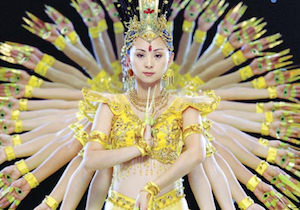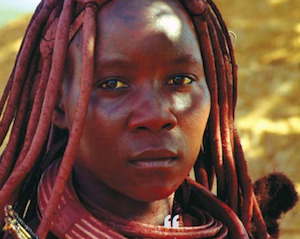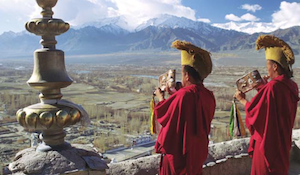
Samsara is a Sanskrit word that refers to the cycle of birth, death, and rebirth, the turning wheel of this earthly existence, upon which we continue to spin until we attain the freedom of liberation.
Director Ron Fricke and Producer Mark Magidson, the duo who brought us the profoundly spiritual and epic documentary film Baraka, have reunited to reveal something about the nature of this wheel of life in their new film, Samsara. With a contemporary tilt, Samsara is a mandala of powerful images paired with emotional music. It is a visual expanse portraying the complexities of the world in which we live, rather than a narrative story that engages the linear mind. On screen, Samsara investigates the wonder of this life as well, the ways in which we can be unconscious, and the unsettled and agitated mind through which reality is perceived. In its awe-inspiring majestic beauty as well as its depiction of some intense truths, this masterpiece is an invitation for us to WAKE UP!
Of the film, Producer Mark Magidson says, “I think on some level we want to feel a deep connection to each other and the life experience beyond those barriers. Impermanence is essentially what the title Samsara means. So we were looking to find that kind of imagery out in the world.”
Magidson sees the film as a visual journey that is thought-provoking without judgment. He explains, “Often we have an intellectual experience, but this film with its moving images and entrancing music was made specifically to create a feeling experience.” He said, “It is like a yoga class in that it’s a moving mediation that brings about a visual sensation.”

We, as viewers, feel the visceral nature of the emotional journey, thanks to the efforts of talented composers, musicians, and vocalists Michael Sterns, Marcello De Francisci, and Lisa Gerrard. The dream-like music nods to different cultural rhythms and allows us to travel the world without a passport in a magical meditation.
Close to the opening scene of Samsara, a trio of wide-eyed costumed Balinese dancers precisely gesture with their hands, inviting us to enter a sacred passageway of visions of Samsara. Throughout the film, we return to colorful images of monks as they carefully constructing a magnificent mandala, one grain of sand at a time, and then ceremoniously destroy their creation. Revisiting the monks at work offers a visual representation of the immense beauty found within the impermanence.
Many of the images, like the monks, reveal an engaged relationship with spirit, including the echo of chanting in the cathedral of Notre Dame, young monks turning a prayer wheel, a sea of pilgrims praying at Mecca.
One of Samsara’s most breathtaking images was the filmmakers’ favorite shoot: an aerial scene of the Bagan pagoda temples scattered amongst lush green of Myanmar or Burma, visually presenting the power of spirit. They filmed the expanse while in a hot air balloon, gliding above the temples.

Portraits abound on screen as we gaze into eyes larger than life, such as a particularly soulful glance of a geisha, cementing our human connection on this spinning wheel. The use of skillful time-lapse photography further entrances, including the mesmerizing eye of a hurricane of Mecca or the people rushing by in subway stations.
The film is a stunning, almost intoxicating visual experience that took me on this journey of Samsara. I felt the beauty, suffering, sadness, and ecstasy that we all experience on the wheel of this life.
The clear message here is that we need to wake up and become more aware of our environment, our consumerism, our consumption, and our collective slave/robotic hypnotic mannerisms. After watching the film, I was left with a feeling of how important is it to love and support each other as love is the universal energy that connects us all to the beauty that exists. When I asked Magidson how the journey of making this film impacted him, he said it taught him to be more compassionate and more grateful—reminders to us all.
Samsara opens in theaters in Los Angeles on August 31: barakasamsara.com.
Suzanne Bryant (suzannebryant.com) is a spiritual psychologist, wellness coach, journalist and the filmmaker of Yoga Is: A Transformational Journey, which releases nationwide on Magnolia Pictures on September 25: yogaismovie.com.
